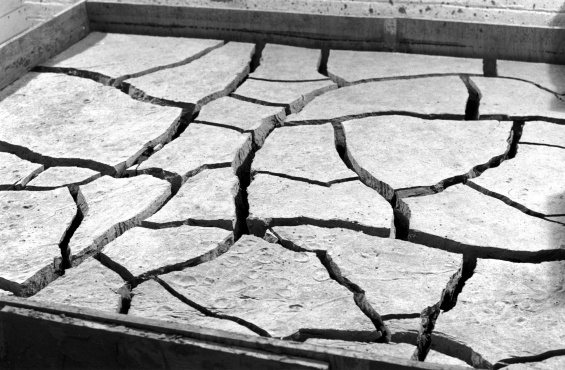 Featured Six Degrees Post
Indexing Liveness: The (In)Animacy of Performance
by Lauren Bakst, R&D Season Fellow
Featured Six Degrees Post
Indexing Liveness: The (In)Animacy of Performance
by Lauren Bakst, R&D Season Fellow
“Ends of the Earth: Land Art to 1974,” Los Angeles

Alice Aycock, Clay #2, 1971/2012. 1,500 pounds of clay mixed with water in wood frame, each: 48 × 48 × 6 in (121.92 × 121.92 × 15.24 cm). Courtesy the artist
In April of 2010, the curator/art historian Miwon Kwon gave the talk “Ends of the Earth (and Back)” at the New Museum. This talk was a part of the Museum’s Propositions series, a public forum for exploring ideas in development. Over a two-day session, an invited speaker introduces a topic he or she is currently investigating, and these developing ideas are responded to, researched, and discussed with the hopes of propelling them forward. At the time of her talk, the Museum of Contemporary Art, Los Angeles, had just announced that Kwon and Philipp Kaiser would co-curate an exhibition titled “Ends of the Earth: Land Art to 1974.” Kwon’s proposition was specifically about the challenges posed by corralling Land art in the museum’s confines. Given the clarity and rigor with which she discussed these challenges, it was clear that she had already spent a lot of time wrestling with them. A full two years later, Kaiser and Kwon opened their catalogue essay with this issue still very much in mind: “Many people will think that a museum exhibition on Land art is impossible.” So when I visited LA this summer with the specific mission to visit “Ends of the Earth,” I braced myself for some kind of respectable failure, a good-intentioned reflection of this impossibility. Instead, I encountered the most rigorous, thoughtful, and engaging exhibition I could possibly imagine.
 Patricia Johanson, Stephen Long, 1968 (still). 16mm film transferred to video, 5 min. Edited by Joanna Alexander, WNET-TV, New York, 2011. Museum of Modern Art Film Archive. © Patricia Johanson. Photo: Courtesy the artist
Patricia Johanson, Stephen Long, 1968 (still). 16mm film transferred to video, 5 min. Edited by Joanna Alexander, WNET-TV, New York, 2011. Museum of Modern Art Film Archive. © Patricia Johanson. Photo: Courtesy the artist
While the grander ideas of the exhibition are notable—the breadth of the subject, the global diversity of artists exploring these issues, the relationship of these works to both art history and political history—I was most struck by the inclusion of unrealized projects in the exhibition. Given the scale of works like Christo and Jeanne-Claude’s Wrapped Coast—One Million Square Feet (1968–69) carefully documented through photos, telegrams, and material samples, it was helpful to remember the many works that exist only as proposals, casualties of legal restrictions, financial obstacles, or shifts in artistic priorities.
The label for Hans Haacke’s Topographic Contour Project, Proposal for Fort Greene Park, Brooklyn (1968) doesn’t indicate if the proposal was ever delivered to the NYC Parks and Recreation board, but I can’t imagine any city approving the project. The drawing indicates two rings of vegetation in the park, proposing that this “area between two topographical contour lines of ten feet depth [be left] uncultivated for the life of the park.” I ride my bike past this park pretty regularly and, lately, a half-joyful/half-terrifying vision of wildly overgrown trees and grass strikes me every time. The several signed, typewritten scores by Paul McCarthy represent much humbler proposals, such as rules for “competitive digging,” outlining an exhaustive-sounding tournament. A second of these proposals, Dirt Desk (1968), simply states: “Pile dirt on your desk and leave it,” an idea that sneaks into my head at least once daily.
 Les Levine, Systems Burn-off × Residual Software, 1969/2012. 1,000 copies each of thirty-one photographs (taken at the March 1969 opening of “Earth Art,” Andrew Dickson White Museum of Art, Cornell University, Ithaca, New York), Jell-O, and chewing gum. Recreated for “Ends of the Earth: Land Art to 1974” at the Museum of Contemporary Art, Los Angeles, 2012. Dimensions variable. Courtesy the artist
Les Levine, Systems Burn-off × Residual Software, 1969/2012. 1,000 copies each of thirty-one photographs (taken at the March 1969 opening of “Earth Art,” Andrew Dickson White Museum of Art, Cornell University, Ithaca, New York), Jell-O, and chewing gum. Recreated for “Ends of the Earth: Land Art to 1974” at the Museum of Contemporary Art, Los Angeles, 2012. Dimensions variable. Courtesy the artist
Unrealized projects have been a source of some discussion lately, particularly through Hans Ulrich Obrist’s book/exhibition Unbuilt Roads. Given the spatial and economic limitations faced by many artists, the relevance of the proposal as an artistic medium could continue to expand, and the examples present in “Ends of the Earth” feel especially compelling. For me, it was great to see the original works and documentation in this exhibition, but inclusions like the Superstudio collages, which envision a massive, gridded superstructure covering the Earth’s surface, communicated more about the expectations and desires of that era. The diagrams and texts for the unrealized projects in “Ends of the Earth” best demonstrate the possibility and excitement present at the birth of Land art, revealing the utopian spirit and boundlessness of this era. The brashness of these projects, unswayed by their own impossibility, provides a model for the exhibition itself, which succeeds in presenting a definitive survey of Land art, despite spatial and proximate limitation.